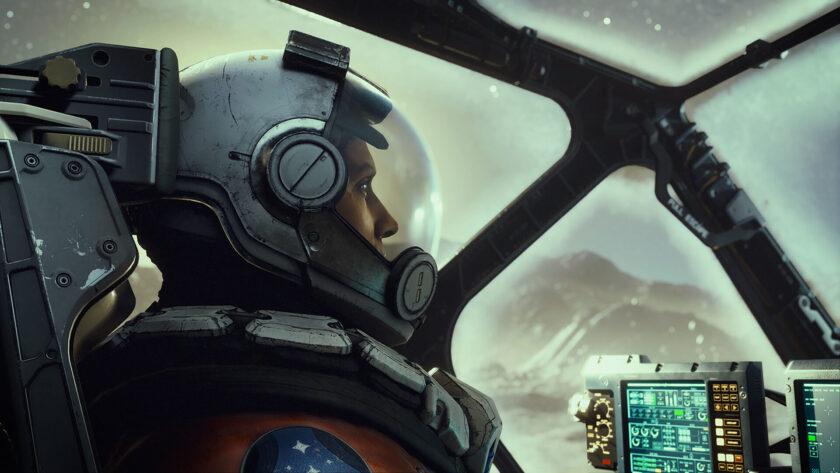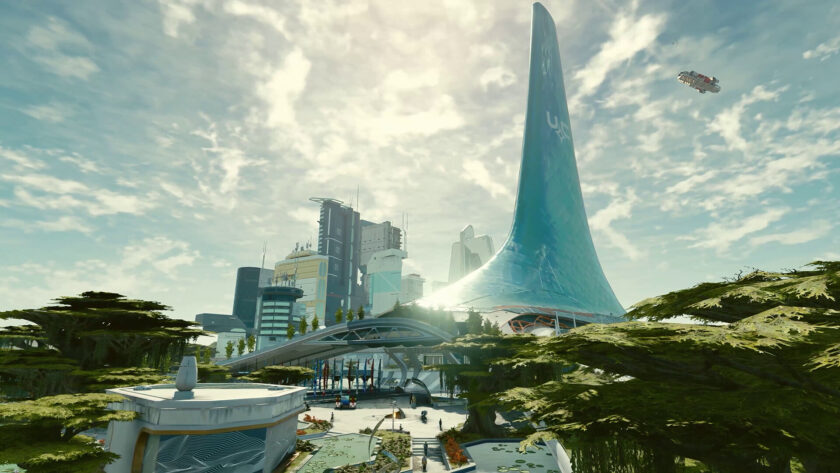
In the realm of role-playing games (RPGs), few names resonate as profoundly as Bethesda Game Studios. With a storied history dating back to the release of The Elder Scrolls: Arena in 1994, this venerable game developer has crafted some of the most immersive and influential RPG experiences in gaming history. From the sprawling worlds of Tamriel in “The Elder Scrolls” series to the post-apocalyptic wastelands of Fallout, Bethesda has consistently pushed the boundaries of storytelling and player agency. Their open-world RPGs have not only captured the hearts of gamers but also set a standard for the genre, making them a household name in the gaming industry.
AT A GLANCE
GENRE: RPG
DEVELOPER: Bethesda Game Studios
PUBLISHER: Bethesda Softworks
RELEASE DATE: 6 Sep, 2023
FINAL SCORE: 9/10
In recent years, the gaming community has been abuzz with anticipation for Bethesda’s next big venture: Starfield. This interstellar odyssey represents the studio’s first foray into the science fiction genre, promising an expansive universe, rich storytelling, and boundless opportunities for exploration. The hype surrounding Starfield has reached astronomical levels, fueled by the studio’s reputation for crafting vast, open worlds teeming with lore, engaging characters, and the freedom to forge one’s destiny. As gamers eagerly await its release, the question looms: Can Bethesda’s legendary formula for RPG success transcend the bounds of space and deliver another unforgettable adventure?
In the following review, we will embark on our own journey through Starfield, examining its gameplay, storytelling, and immersion to determine whether it lives up to the legacy of Bethesda Game Studios and the immense anticipation it has generated. Let us delve into the unknown and see if Starfield shines as a new beacon in the constellation of RPG gaming.
Story
Bethesda Game Studios has long been revered for its mastery of world-building and storytelling in the RPG genre. With titles like The Elder Scrolls and Fallout series under their belt, they’ve set a high bar for rich, immersive narratives and some of the most memorable side quests in gaming. Starfield steps into this legacy, often shining brightly and reaching the pinnacle of Bethesda’s storytelling prowess.
However, even amidst their narrative brilliance, Starfield grapples with some familiar Bethesda game issues that can’t be overlooked. The game’s early hours can feel sluggish, taking their time to set the stage and immerse players in this vast cosmic playground. As with previous titles, the main storyline sometimes takes a backseat to the multitude of engaging side quests, which can create a lack of urgency in the overarching narrative.

One notable aspect where Starfield stands out is in its companions and factions. Companions in the game feel remarkably believable and add depth to the storytelling. What’s particularly impressive is the consistency in the factions you encounter. In earlier Bethesda games, joining a hostile faction often left the player immune to attacks from their fellow faction members, which broke immersion. In Starfield, this inconsistency has been addressed, making interactions with factions more realistic and engaging.
One of the standout features of Starfield is the significance of player choices. It’s in this aspect that the game sets itself apart from many RPGs on the market. Choices in Starfield go beyond the superficial, forcing players to carefully consider their actions and decisions. Over the course of the game, the choices made during character creation and throughout the story matter profoundly. Whether it’s aligning with a faction, sparing or eliminating certain characters, or forging alliances, each choice feels impactful and is woven seamlessly into the narrative. This level of meaningful choice ensures that the character you build truly matters, presenting players with constant opportunities to shape their journey.
Gameplay
Starfield marks a significant leap forward for Bethesda Game Studios in terms of gameplay polish and variety, delivering one of the most refined experiences in their storied history. The game is a testament to their dedication to crafting a captivating player experience.
Let’s start with the gameplay, arguably the most polished aspect of Starfield. The game offers a plethora of options and boasts the best gunplay we’ve seen in a Bethesda RPG to date. The combat encounters are more dynamic and engaging, making each firefight a thrilling experience.
Now, let’s delve into the heart of the game—the planets. Starfield presents an impressive array of celestial bodies, each with its unique charm. While some may appear barren with scattered points of interest, typically abandoned outposts, it’s the environmental diversity and player agency that truly shine. The ability to construct your outposts, gather resources, and engage in roleplay as a space explorer adds depth to the gameplay. Player freedom remains a focus, whether it’s embracing the life of a space pirate or becoming a philanthropic helper of fellow spacefarers.
Among the planets, the more populated ones are a testament to the game’s astonishing variety. These worlds showcase many contrasting fauna, flora, environments, NPCs, and settlements. Unlike the settlement-building of Fallout 4, Starfield introduces bustling cities teeming with NPCs offering quests and opportunities for exploration. Starfields planets are incredibly detailed and beautifully designed, serving as a testament to Bethesda’s commitment to world-building.

Starfield offers an overwhelming amount of content, and its gameplay systems are thoughtfully fleshed out. The game’s depth ensures that players are constantly engaged and motivated to explore and experiment with its numerous mechanics. Ship-building is extensive, yet surprisingly accessible, allowing players to quickly experiment with various configurations. Crafting remains simple and satisfying, with many crafting options tied to skill progression.
While no Bethesda game would be complete without a few bugs, Starfield stands out as one of their least buggy releases. In roughly 30 hours of gameplay, the bugs encountered were predominantly visual and had minimal impact on the overall experience. While the game isn’t without its quirks, it manages to maintain its charm despite the occasional hiccup.
Visuals, Audio, and Technical Performance
Visually, Starfield emerges as Bethesda’s most visually stunning creation to date, standing shoulder to shoulder with some of the most impressive titles released in this generation. It’s a notable achievement for a studio that has often faced criticism for certain visual aspects. One area where significant strides have been made is in the realm of NPC faces.

The character models and animations represent a marked improvement over previous titles. At times, the realism achieved in the facial animations is almost astonishing. The art style masterfully captures the essence of a sci-fi universe, creating an immersive atmosphere that draws players deeper into the game’s world. As with previous Bethesda titles, Starfield excels at environmental storytelling, enriching its universe with intricate details. From meticulously designed planets to awe-inspiring cities, the game consistently evokes a sense of wonder, harkening back to the studio’s legacy, dating as far back as Morrowind.

The auditory aspect of Starfield is equally impressive. Voice acting is top-notch, offering a remarkable variety that surpasses the studio’s previous endeavors. Inon Zur, once again at the helm of the soundtrack, delivers a musical masterpiece that complements the gameplay experience perfectly, immersing players in the cosmic world of Starfield.
On the technical front, Bethesda has not pulled any punches with Starfield. The game’s system requirements are demanding, and it places a substantial load on hardware. While the visuals are undeniably spectacular, some players have noted that optimization could have been improved. Achieving stable frame rates often necessitates enabling features like FSR2 unless you’re equipped with a high-end system. However, it’s worth noting that we did not suffer from game-breaking bugs, and we had a relatively smooth technical experience on our system, which is a 5600X paired with an RTX 3070.
It’s crucial to remember that the Bethesda community’s modding prowess is often as much a part of the experience as the base game itself. Starfield is sure to become a canvas for creative modders who will expand, enhance, and innovate in ways that could exceed our wildest expectations. Whether it’s adding new quests, enhancing visuals, or introducing entirely new gameplay mechanics, mods will undoubtedly breathe fresh life into the game and extend its longevity.
Final Thoughts
Summary
Starfield stands as a testament to Bethesda's expertise in crafting expansive open worlds and narratives. With its polished gameplay, it marks a notable improvement over their previous titles. However, it doesn't completely evade the shadows of typical Bethesda quirks. The story in Starfield is a rich tapestry of depth and choice, but it can be a slow-burning journey that occasionally leaves the sense of urgency behind. Nevertheless, the companions and factions within the game shine with believability and consistency, significantly enhancing the overall narrative. Where Starfield truly excels is in its gameplay. It introduces extensive ship-building, refined gunplay, and captivating planet exploration, offering players a universe teeming with possibilities. However, it's important to note that the game has hefty technical demands, which may challenge some players. Despite this, the visual and auditory spectacles on offer make the journey unquestionably worthwhile. While it may not be without its drawbacks, the game's strengths in world-building, storytelling, and gameplay make it a cosmic adventure well worth embarking upon for fans of open-world RPGs.






